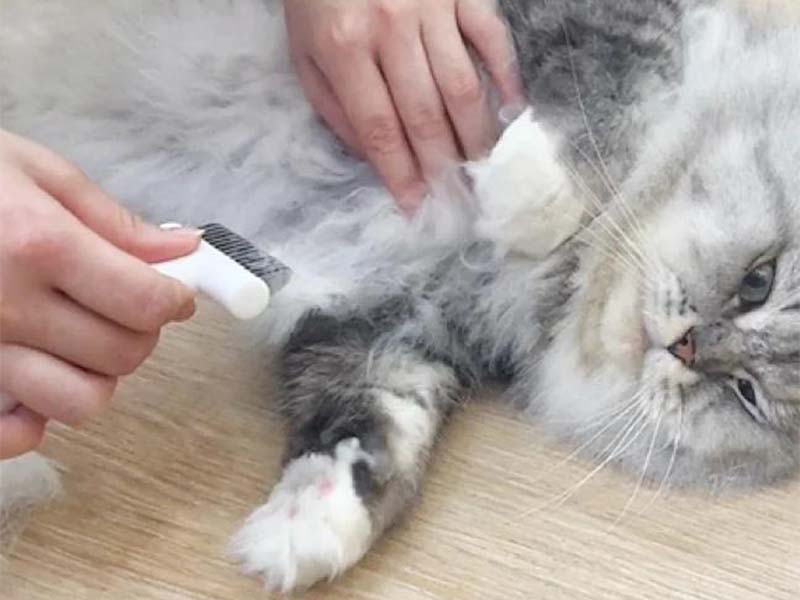
Menguruskan bulu kucing yang kusut boleh menjadi masalah sebenar. Gumpalan yang ketat itu bukan sahaja tidak sedap dipandang; jika anda membiarkannya, ia boleh menyebabkan jangkitan kulit, menyukarkan kucing anda bergerak, dan juga mencederakannya. Anda boleh menyelesaikan masalah ini. Mari kita pecahkannya kepada lima langkah yang jelas dan mudah diikuti.
Langkah 1: Lembutkan Tikar Terlebih Dahulu
Jangan sekali-kali cuba menarik tikar dengan sikat—ini akan mencederakan kucing anda dan mungkin menggaru kulit sensitif mereka. Sebaliknya, anda perlu melembutkan tikar terlebih dahulu.
Berikut adalah beberapa cara mudah untuk melakukannya:
Gunakan semburan pengurang kusut khusus haiwan peliharaan: Semburan ini direka untuk melonggarkan tikar yang keras, jadi ia berfungsi dengan baik.
Berikan mereka mandian air panas: Air suam dan syampu akan melembutkan tikar, menjadikannya lebih mudah diurus kemudian. Pastikan sahaja anda menggunakan syampu yang dibuat untuk kucing—syampu manusia mengeringkan kulit mereka.
Selepas menggunakan sebarang kaedah pelembutan, biarkan ia selama beberapa minit. Kemudian gunakan jari anda untuk menarik tikar ke tepi sedikit dengan lembut.
Langkah 2: Sikat Dengan Perlahan dan Perlahan
Setelah tikar lembut, anda boleh mula menyikat—tetapi ketekunan adalah kunci di sini.
Pilih alat yang betul: Sikat logam bergigi lebar atau alat pemecah tikar khas berfungsi dengan baik. Untuk kucing berbulu panjang, berus licin atau berus pin juga boleh membantu.
Mulakan di hujung: Jangan sikat betul-betul di pangkal bulu berhampiran kulit. Mulakan di hujung bulu yang kusut dan gerakkan perlahan-lahan ke arah kulit.
Pegang pangkal tikar: Untuk mengelakkan daripada menarik kulit kucing anda, gunakan sebelah tangan untuk memastikan pangkal tikar rapat ke arah kulit mereka. Gunakan tangan yang lain untuk menyikat.
Jika tikar itu besar, gunakan jari atau sikat anda untuk memotongnya kepada bahagian yang lebih kecil terlebih dahulu, kemudian sikat setiap bahagian keluar.
Langkah 3: Bila Hendak Memotong Tikar
Sesetengah tikar terlalu ketat, terlalu dekat dengan kulit, atau terlalu besar untuk disikat. Dalam kes ini, memotongnya adalah pilihan yang paling selamat.
Berhati-hati: Jangan sekali-kali menggunakan gunting tajam berhampiran kulit kucing anda. Kucing akan keluar secara tiba-tiba, dan mudah untuk memotongnya dengan teruk.
Gunakan gunting berhujung tumpul: Gunting dandanan tumpul atau gunting kecil adalah lebih selamat.
Luncurkan sikat di bawah: Cara paling selamat adalah dengan berhati-hati memasukkan sikat di antara tikar dan kulit kucing anda—ini bertindak sebagai penghalang. Kemudian potong tikar di atas sikat, hanya untuk menghiris bulunya. Dengan cara ini, anda tidak akan mencederakan kulit mereka.
Jika tikar kelihatan terlalu sukar untuk dikendalikan, atau anda tidak yakin untuk melakukannya sendiri, hentikan dan dapatkan bantuan profesional.
Langkah 4: Legakan Kulit dan Periksa Masalah
Selepas menanggalkan tikar, kulit di bawah mungkin merah, sakit, atau merengsa.
Periksa kawasan sekitar dengan teliti: Lihat kulit di mana tikar berada. Jika anda melihat kemerahan, ruam, luka, atau tanda-tanda parasit, hubungi doktor haiwan anda—ini mungkin memerlukan rawatan.
Biarkan kucing anda berehat: Seluruh proses boleh menjadi stres. Selepas selesai, berikan mereka makanan kegemaran atau beberapa haiwan peliharaan yang lembut untuk membantu mereka bertenang.
Langkah 5: Elakkan Tikar daripada Kembali
Cara terbaik untuk merawat tikar adalah dengan menghentikannya daripada terbentuk.
Berus secara berkala: Ini adalah langkah terpenting. Untuk kucing berbulu panjang, memberus setiap hari adalah ideal. Untuk kucing berbulu pendek, memberus beberapa kali seminggu biasanya sudah cukup. Berus secara berkala menghilangkan bulu bebas sebelum ia kusut.
Gunakan berus yang betul: Bulu yang berbeza memerlukan alat yang berbeza. Kucing berbulu panjang kerap memerlukan sikat logam atau berus peniti, manakala kucing berbulu pendek boleh didandan dengan berus getah atau sarung tangan dandanan.
Mandikan kucing sekali-sekala: Tab mandi sekali-sekala dengan syampu khusus kucing memastikan bulunya bersih dan kurang terdedah kepada kusut. Tetapi jangan mandikan mereka terlalu kerap—mandi terlalu banyak akan mengeringkan kulit mereka.
Mengendalikan kusut memerlukan kesabaran. Sentiasa utamakan keselesaan dan keselamatan kucing anda. Jika kusut kelihatan terlalu keras, meminta bantuan daripada penjaga kusut profesional atau doktor haiwan sentiasa merupakan pilihan yang terbaik. Rutin dandanan biasa adalah pertahanan terbaik anda terhadap kusut, memastikan bulu kucing anda sihat dan cantik.
